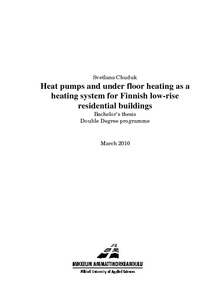Viability Of a Radiative Collector and Emitter Device
Perez Lema, Carles (2020)
Perez Lema, Carles
2020
All rights reserved. This publication is copyrighted. You may download, display and print it for Your own personal use. Commercial use is prohibited.
Julkaisun pysyvä osoite on
https://urn.fi/URN:NBN:fi:amk-2020092220639
https://urn.fi/URN:NBN:fi:amk-2020092220639
Tiivistelmä
The Radiative Collector and Emitter (RCE) device is a new technology that is being developed by the research group SEMB from the University of Lleida. This device could be an alternative way to produce Domestic House Water and cold water for all kind of buildings.
In the first part of the thesis, the principles and the functionality of the RCE are explained with respect to solar collecting and the radiative cooling phenomenon. In addition, background information relating to the RCE technology are developed and discussed.
Afterwards, a calculation with EES and a simulation with TRNSYS is conducted in order to compare the RCE technology with three different systems: RCE + Photovoltaic Panel + Water source heat pump, Photovoltaic Panel + Geothermal heat pump, and Photovoltaic Panel + Air source heat pump.
The findings indicate that for cooling purposes, the power of the RCE device in front of the systems using photovoltaic panels is not high enough (maximum power of 29,29 W/m2) to be a renewable alternative. However, for heating purposes, the RCE is a capable technology (maximum power of 69,13 W/m2) and therefore, as a unique device that can satisfy both demands, cooling and heating, the RCE device could be a considered viable technology to produce DHW and cold water cleanly and sustainably.
In the first part of the thesis, the principles and the functionality of the RCE are explained with respect to solar collecting and the radiative cooling phenomenon. In addition, background information relating to the RCE technology are developed and discussed.
Afterwards, a calculation with EES and a simulation with TRNSYS is conducted in order to compare the RCE technology with three different systems: RCE + Photovoltaic Panel + Water source heat pump, Photovoltaic Panel + Geothermal heat pump, and Photovoltaic Panel + Air source heat pump.
The findings indicate that for cooling purposes, the power of the RCE device in front of the systems using photovoltaic panels is not high enough (maximum power of 29,29 W/m2) to be a renewable alternative. However, for heating purposes, the RCE is a capable technology (maximum power of 69,13 W/m2) and therefore, as a unique device that can satisfy both demands, cooling and heating, the RCE device could be a considered viable technology to produce DHW and cold water cleanly and sustainably.
Kokoelmat
Samankaltainen aineisto
Näytetään aineisto, joilla on samankaltaisia nimekkeitä, tekijöitä tai asiasanoja.
-
Heat pumps and under floor heating as a heating system for Finnish low-rise residential buildings
Chuduk, Svetlana (Mikkelin ammattikorkeakoulu, 2010)In bachelor’s thesis the study of under floor heating system with ground source heat pump for the heat transfers fluid heating is considered. The case study is low-rise residential building in Finland with under floor ... -
Arrangement for recovering and utilizing the waste heat generated onboard a ship in district heating
Vuorinen, Otto (2021)The objective of the present Master’s thesis was to study the feasibility of an idea behind a Finnish patent to utilize the waste heat generated onboard a ship by it’s engines and to use it in an onshore application to ... -
District Heating Rehabilitation in Russia : The hydro-ejector system's replacement with the plate heat exchanger
Vuorensola, Jussi (Oulun ammattikorkeakoulu, 2015)This thesis has two assigners. The first one is Karelia institute, which wanted more information about the hydro-ejector's functions and Russian heating norms. Besides of that Jupra Oy, which wanted to find out about ...



